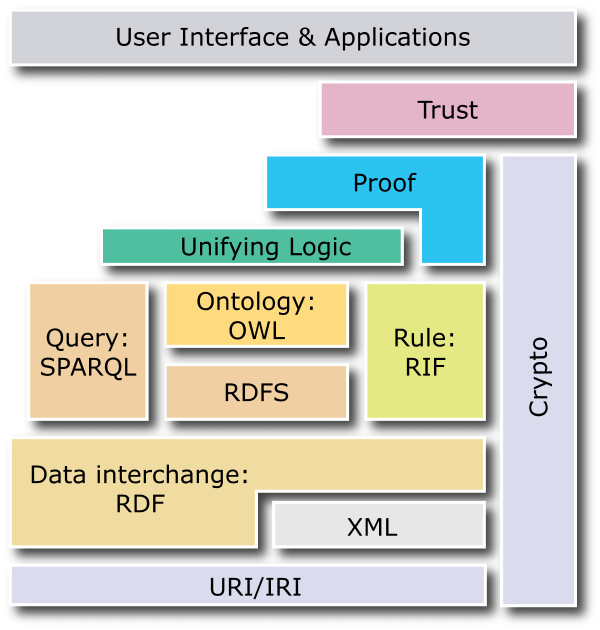Semantic Web#
Introduction
Bien, le web sémantique est un concept qui, il me semble, est toujours en train d’être définit. Nous avons des tags sémantique natifs du html (
Introduction#
Note
Use following termonologie to add definitions
Note
Rich results from google search
Readings#
Note
To download, read and put in refs
More#
Vocabulary
RDF : Data model for metadata
XML
Ontology
JSON
Knowledge graph
JATS: Journal Article Tag Suite Source - xml for scientif articles / publications
Questions
- How does myst metadata translate into html (is it meta tags in head ?)
- Can I add extra metadata within elements by using block breaks
+++ {"meta": "data"}
Semantic Web and Executable books#
‣ Semantic Web and Science #
Note
To investigate because sphinx extension available !! :)
‣ Semantic Web and Science #
Softwares
‣ ‣ Example: Life Sciences#
Note
Good example with overview of softwares etc … To read!
‣ ‣ Example: SciData#
SciData is a data model for scientific data (JSON-LD implementation) that provides a ontologically defined framework for organizing both the data and metadata from scientific experiments, calculations, and theories
From RAW HTML To Metadata#
- [Simple HTML Ontology Extensions](Simple HTML Ontology Extensions)
to check: Microformat
‣ Microdata #
Sometimes, it is desirable to annotate content with specific machine-readable labels, e.g. to allow generic scripts to provide services that are customized to the page, or to enable content from a variety of cooperating authors to be processed by a single script in a consistent manner. For this purpose, authors can use the microdata features described in this section. Microdata allows nested groups of name-value pairs to be added to documents, in parallel with the existing content.
- Info
- itemscope
- itemtype
- itemid
- itemprop
- itemref
- datetime
I don’t really use html tags (ie it is the point of JupyterBook to releive you from using use by building html from markdown files). However there is a few exception to this rule:
To explain complicated words I use span tags.
- Ontology
Note
Should I start putting span divs with microdata tags to be able to make my data linkable ?
Ask Alessio
‣ ‣ Example #
<div itemscope itemtype ="https://schema.org/Movie">
<h1 itemprop="name">Avatar</h1>
<div itemprop="director" itemscope itemtype="https://schema.org/Person">
Director: <span itemprop="name">James Cameron</span> (born <span itemprop="birthDate">August 16, 1954</span>)
</div>
<span itemprop="genre">Science fiction</span>
<a href="../movies/avatar-theatrical-trailer.html" itemprop="trailer">Trailer</a>
</div>
Microdata vocabularies do not provide the semantics, or meaning of an item
use vocabularies available on the web -> Schema.org
From Metadata in HTML to RDF#
- Different approaches - Good but pretty outdated (2001)
<head>
<title>My Document</title>
<link rel="meta" type="application/rdf+xml" href="meta.rdf"/>
</head>
Ontologies#
‣ Definition #
\( {\displaystyle i=\langle C_{i},R_{i},I_{i},T_{i},V_{i}\rangle } \)
- C is the set of classes,
- R is the set of relations,
- I is the set of individuals,
- T is the set of data types,
- V is the set of values,
Ontologies come in different serialisations, formalisms, and variants For example, their are a 9 different release files associated with an ontology.
- OWL
- RDF(s)
- OBO
- Tools
I would like to:
- ?
- Article - from taxonomy to ontology
‣ Build a simple ontologie #
Protégé
Open Source
WebVOWL
Else
Tutorial serie:
Software: Protege
- Class / Subclass
- The different foler / subfolder
- Object properties can be given sense by adding **Characteristic
- isMarkdown
- is Folder
Note
Relation from ensemble theory
- Fuctional
- Transitive
- Symetric
- Reflexive
To check
‣ Online tutorials #
‣ Ontology matching #
To do#
To do
- Think about what is important in the project
- Define specific type of content within websiteand allocate proper description
- look in Schema.org for specific tag
- embed RDF into web-page
To do
- Check how to implement into JupyterBook
- Github issue ?
‣ What do I need to do #
- Have a look at the preexisting ontologies (?) and select the one that are of interest
- Think about what is important and need highlighting
Knowledge graphs#
Other examples
- from Angelo - This data is extracted from knowledge graph. (is it ?) - How?
Question
- Should I embed my own work (thesis) there ?
- Better to generate my own parent website to create a publication plateform linking different work
- Blog article I: Transforming Tabular Data into Personalized, Componentized Content using Knowledge Graphs in Python
- Blog article II: Content Personalization with Knowledge Graphs in Python
Web-site architecture mapping
- networkx: Python library to plot knowledge graphs
- Notebook
- Storage
- Files, folder mapping
- Ontology (Webvowl, RDF from CSV)
RSS ?#
- RSS feed
- Atom
